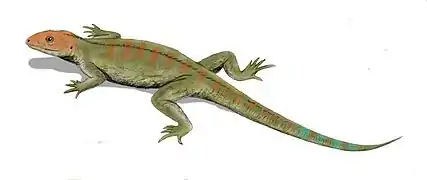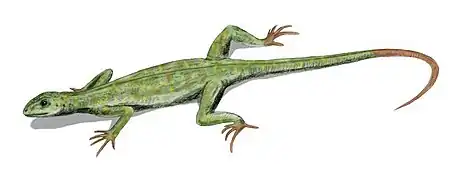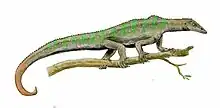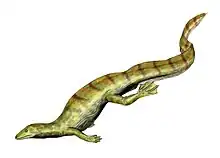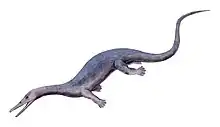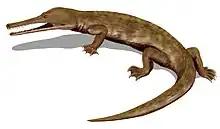| Eureptiles | |
|---|---|
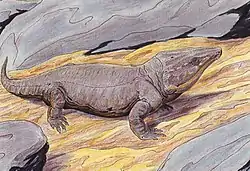 | |
| Labidosaurikos meachami, an early eureptilian of the family Captorhinidae | |
| Scientific classification | |
| Domain: | Eukaryota |
| Kingdom: | Animalia |
| Phylum: | Chordata |
| Class: | Reptilia |
| Clade: | Eureptilia Olson, 1947 |
| Subgroups | |
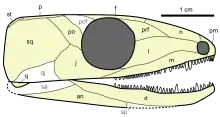
Eureptilia ("true reptiles") is one of the two major subgroups of the clade Sauropsida, the other one being Parareptilia. Eureptilia includes Diapsida (the clade containing all modern reptiles and birds), as well as a number of primitive Permo-Carboniferous forms previously classified under Anapsida, in the old (no longer recognised) order "Cotylosauria".
Eureptilia is characterized by the skull having greatly reduced supraoccipital, tabular, and supratemporal bones that are no longer in contact with the postorbital. Aside from Diapsida, the group notably contains Captorhinidae, a diverse and long lived (Late Carboniferous-Late Permian) clade of initially small carnivores that later evolved into large herbivores.[1] Other primitive eureptiles such as the "protorothyrids" were all small, superficially lizard-like forms, that were probably insectivorous.[2] One primitive eureptile, the Late Carboniferous "protorothyrid" Anthracodromeus, is the oldest known climbing tetrapod.[3] Diapsids were the only eureptilian clade to continue beyond the end of the Permian.
Classification
Eureptilia was defined as a stem-based clade, specifically, the most inclusive clade containing Captorhinus aguti and Petrolacosaurus kansensis but not Procolophon trigoniceps, by Tsuji and Müller (2009).[4] The cladogram here was modified after Muller and Reisz (2006):[5]
| Reptilia |
| |||||||||||||||||||||||||||||||||||||||||||||||||||||||||
References
- ↑ Brocklehurst, Neil (2017-04-13). "Rates of morphological evolution in Captorhinidae: an adaptive radiation of Permian herbivores". PeerJ. 5: e3200. doi:10.7717/peerj.3200. ISSN 2167-8359. PMC 5392250. PMID 28417061.
- ↑ Canoville, Aurore; Laurin, Michel (2010-05-19). "Evolution of humeral microanatomy and lifestyle in amniotes, and some comments on palaeobiological inferences: AMNIOTE MICROANATOMY AND PALAEOBIOLOGICAL INFERENCE". Biological Journal of the Linnean Society. 100 (2): 384–406. doi:10.1111/j.1095-8312.2010.01431.x.
- ↑ Mann, Arjan; Dudgeon, Thomas W.; Henrici, Amy C.; Berman, David S; Pierce, Stephanie E. (2021). "Digit and Ungual Morphology Suggest Adaptations for Scansoriality in the Late Carboniferous Eureptile Anthracodromeus longipes". Frontiers in Earth Science. 9: 440. Bibcode:2021FrEaS...9..440M. doi:10.3389/feart.2021.675337. ISSN 2296-6463.
- ↑ Benton, M. J., Donoghue, P. C., Asher, R. J., Friedman, M., Near, T. J., & Vinther, J. (2015). "Constraints on the timescale of animal evolutionary history." Palaeontologia Electronica, 18.1.1FC; 1-106; palaeo-electronica.org/content/fc-1
- ↑ Muller, J. and Reisz, R.R. (2006). "The phylogeny of early eureptiles: Comparing parsimony and Bayesian approaches in the investigation of a basal fossil clade." Systematic Biology, 55(3):503-511. doi:10.1080/10635150600755396
External links
- Eureptilia examples of some Permian species
- Eureptilia

